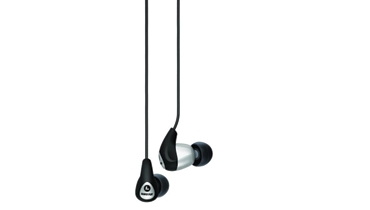In-Ear Headphones Face Off Page 2

Key Features |
| $400 Shure.com |
| • Accessories: 8 pair ear tips, cleaning tool, airline adapter, 1/4-in adapter, plug-in inline volume control, zippered oval carrying case • Impedance/Sensitivity: 22 ohms/109 db SPL/mW |
Shure SE420
As an early leader and innovator in the inear category, Shure has a great rep among audiophiles. It offers a full line of five models, of which the SE420 is one notch from the top. It features a dual-armature two-way design with a dedicated woofer and tweeter, and comes with a complete accessory package that includes an optional in-line volume control.
Cosmetically, the small bulbous earpieces are nothing special, but their black pearlized plastic casings (they're available in white as well) feel extremely solid and well built compared with some of the more delicate 'phones I tested. I also liked the angled nozzles for the ear tips, which helps you get them better situated, and the rubberized material at the back of the small earpieces, which makes them easier to grip. Nice touches, both.
PERFORMANCE
Sonically, the SE420's character was marked by a well-defined midrange and crisp highs that lent extra detail to voices but also notably etched sound on transients. These qualities brought out the recessed vocals on my Common Rotation track and really put some snap into the snare drum on "Wishing Well." Jason Weaver also sounded great; the increased presence suited the immediacy of his voice on this track. But it could also be a bit grating on some material. For example, there was a bit of an edge to the violin solo on "The Gypsy."
The Shure's downside was bass performance that was around the middle of this pack, and some compression of dynamics compared with the best of the lot and also with my reference 'phones. Test tones revealed that bass energy really started to fall off below 30 Hz (the better 'phones could still move decent air down to 25 or even 20 Hz), which resulted in a low end that was heard but not really felt. That bit of extra oomph was missed on most of my bass-dependent tracks and probably contributed to the midrange seeming a touch thin.
The Shure struggled with the Stravinsky orchestral track, delivering reduced impact and clarity on the timpani as compared with the better 'phones and less openness and air around instruments. It also showed strain when the movement got loud and busy; the fairly heavy demands it put on the iPod's amplifier forced me to cut back the volume on this track to make sure my iPod was delivering a clean signal.
BOTTOM LINE
Considering that its price is up there among the most expensive, the Shure SE420 isn't really the strongest of contenders in this group.
- Log in or register to post comments



































































